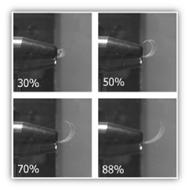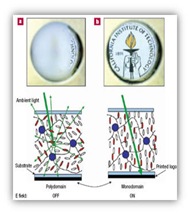
These main chain elastomers are auxetic materials, which means they become
thicker when stretched, the opposite of conventional materials that thin
when stretched. This makes auxetic LCE ideal candidates for novel fasteners that resist being
pulled-out and seals that seat better under compression, and replacement
blood vessels.
The LCE is composed of rigid rods connected by a flexible linker molecule, (illustrated
above). In alternating fashion, the rods are terminally (end on)
or laterally (side on) connected to each other via a crosslinker molecules. Under no
strain, the terminal attached and lateral attached rod lie parallel to each
other (top), while under strain, the laterally attached components tend to
orient perpendicular to the polymer chain, resulting in a material that
expands when pulled.
Images: C. He, A. Griffin. Phys. Stat. Sol. (b) 242, 2005

This material exhibits large-amplitude, reversible deformations when exposed to certain types of solvent vapor. The mesogens have a free carboxylic acid group that complex with each other to form a hydrogen bond network film. When exposed to solver vapor, (or immersed in solvent), the hydrogen bond network is interrupted, resulting in macroscopic deformation of the film on the millisecond timescale.

These materials are free standing liquid crystalline gels with exceptional optical uniformity and uniform cross link density, that exhibit fast reorientation dynamics. This material is comprised of an ABA type polymer, with long B sections holding the LC component, flanked by LC-phobic A end blocks. The polymer network undergoes a phase separation, with the terminal blocks aggregating , (blue circles) to form lattice points. This gel is electrically switchable by an electric field, as shown in the pictures. With no field, the gel scatters light, but with an electric field, the LC align well, and light can pass through the gel, making this material ideal for display applications.
Source: Kemp, Cornfield. et al. Nature Materials (3) 2004


























